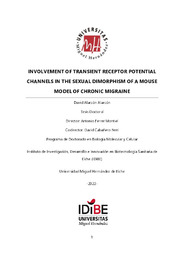Por favor, use este identificador para citar o enlazar este ítem:
https://hdl.handle.net/11000/29519
Involvement of transtient receptor potential channels in the sexual dimorphism of a mouse model of chronic migraine
Título :
Involvement of transtient receptor potential channels in the sexual dimorphism of a mouse model of chronic migraine |
Autor :
Alarcón Alarcón, David  |
Tutor:
Ferrer-Montiel, Antonio  |
Editor :
Universidad Miguel Hernández de Elche |
Departamento:
Departamentos de la UMH::Bioquímica y Biología Molecular |
Fecha de publicación:
2023-02-16 |
URI :
https://hdl.handle.net/11000/29519 |
Resumen :
Chronic pain strongly deteriorates quality of life and lacks adequate treatment, the
impact of chronic pain is especially crude in women originating inequality in pain
assessment and treatment. We chose a model of chronic migraine to study the effect of
sex in pain chronification, as migraine is considered a chronic sensitization that presents
a strong sexual dimorphism. We used in vitro and murine models to investigate the role
of TRP channels and neuropeptide CGRP in the sexual dimorphism of this chronic pain
model. The model of chronic migraine was established by repeated intraperitoneal
injections of nitroglycerin in male and female C57BL/6J adult mice. We used mechanical
sensitivity measurements by Von Frey filaments to monitor sensory hypersensitivity of
mice under chronical nitroglycerin administration. To study of the role of TRPA1, TRPM8
and CGRP in model, we used knockout mice and pharmacological tools. We further
studied the activity of these genes by calcium imaging and their expression by qPCR in
trigeminal neurons and cell lines expressing the murine and human receptors. Finally,
CGRP release was assessed by immunocytochemistry. The chronic migraine model was
characterized by a stronger chronification process in females. Furthermore, CGRP
knockout mice or treated with a CGRP exocytosis inhibitor did not develop chronic pain.
We found out that TRPA1 is essential for nitroglycerin sensitization of the animals as it
functions as a nitroglycerin receptor, and this activation produced the CGRP release from
trigeminal neurons. TRPM8 did present differential activity in-vivo attending to the sex,
playing a protective role in male mice that was testosterone-dependent. In-vitro
experiments could corroborate the agonistic activity of testosterone over TRPM8. In
summary, we present a migraine model based on nitroglycerin administration that shares
characteristics with migraine in humans, as it presents stronger effect in female animals
and is CGRP dependent. We described TRPA1 as the main trigger of hypersensitivity
through CGRP release, while TRPM8 had a protective effect that was sex dependent,
counterbalancing hypersensitivity exclusively in males. Finally, we propose that TRPM8
activation in males by testosterone overrides chronic sensitization produced by
nitroglycerin administration.
|
Palabras clave/Materias:
Biología molecular
Biología celular
Neurobiología molecular
Neurofisiología |
Área de conocimiento :
CDU: Ciencias puras y naturales: Biología |
Tipo documento :
application/pdf |
Derechos de acceso:
info:eu-repo/semantics/openAccess |
Aparece en las colecciones:
Tesis doctorales - Ciencias e Ingenierías
|
 La licencia se describe como: Atribución-NonComercial-NoDerivada 4.0 Internacional.
La licencia se describe como: Atribución-NonComercial-NoDerivada 4.0 Internacional.
 La licencia se describe como: Atribución-NonComercial-NoDerivada 4.0 Internacional.
La licencia se describe como: Atribución-NonComercial-NoDerivada 4.0 Internacional.
.png)
